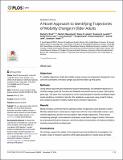| dc.contributor.author | Ward, Rachel E. | en_US |
| dc.contributor.author | Beauchamp, Marla K. | en_US |
| dc.contributor.author | Latham, Nancy K. | en_US |
| dc.contributor.author | Leveille, Suzanne G. | en_US |
| dc.contributor.author | Percac-Lima, Sanja | en_US |
| dc.contributor.author | Kurlinski, Laura | en_US |
| dc.contributor.author | Ni, Pengsheng | en_US |
| dc.contributor.author | Goldstein, Richard | en_US |
| dc.contributor.author | Jette, Alan M. | en_US |
| dc.contributor.author | Bean, Jonathan F. | en_US |
| dc.date.accessioned | 2017-02-18T01:58:21Z | |
| dc.date.issued | 2016 | en_US |
| dc.identifier.citation | Ward, Rachel E., Marla K. Beauchamp, Nancy K. Latham, Suzanne G. Leveille, Sanja Percac-Lima, Laura Kurlinski, Pengsheng Ni, Richard Goldstein, Alan M. Jette, and Jonathan F. Bean. 2016. “A Novel Approach to Identifying Trajectories of Mobility Change in Older Adults.” PLoS ONE 11 (12): e0169003. doi:10.1371/journal.pone.0169003. http://dx.doi.org/10.1371/journal.pone.0169003. | en |
| dc.identifier.issn | 1932-6203 | en |
| dc.identifier.uri | http://nrs.harvard.edu/urn-3:HUL.InstRepos:30370999 | |
| dc.description.abstract | Objectives: To validate trajectories of late-life mobility change using a novel approach designed to overcome the constraints of modest sample size and few follow-up time points. Methods: Using clinical reasoning and distribution-based methodology, we identified trajectories of mobility change (Late Life Function and Disability Instrument) across 2 years in 391 participants age ≥65 years from a prospective cohort study designed to identify modifiable impairments predictive of mobility in late-life. We validated our approach using model fit indices and comparing baseline mobility-related factors between trajectories. Results: Model fit indices confirmed that the optimal number of trajectories were between 4 and 6. Mobility-related factors varied across trajectories with the most unfavorable values in poor mobility trajectories and the most favorable in high mobility trajectories. These factors included leg strength, trunk extension endurance, knee flexion range of motion, limb velocity, physical performance measures, and the number and prevalence of medical conditions including osteoarthritis and back pain. Conclusions: Our findings support the validity of this approach and may facilitate the investigation of a broader scope of research questions within aging populations of varied sizes and traits. | en |
| dc.language.iso | en_US | en |
| dc.publisher | Public Library of Science | en |
| dc.relation.isversionof | doi:10.1371/journal.pone.0169003 | en |
| dc.relation.hasversion | http://www.ncbi.nlm.nih.gov/pmc/articles/PMC5179086/pdf/ | en |
| dash.license | LAA | en_US |
| dc.subject | People and Places | en |
| dc.subject | Population Groupings | en |
| dc.subject | Age Groups | en |
| dc.subject | Elderly | en |
| dc.subject | Biology and Life Sciences | en |
| dc.subject | Anatomy | en |
| dc.subject | Musculoskeletal System | en |
| dc.subject | Limbs (Anatomy) | en |
| dc.subject | Legs | en |
| dc.subject | Medicine and Health Sciences | en |
| dc.subject | Knees | en |
| dc.subject | Geriatrics | en |
| dc.subject | Geriatric Rehabilitation | en |
| dc.subject | Rehabilitation Medicine | en |
| dc.subject | Physical Sciences | en |
| dc.subject | Physics | en |
| dc.subject | Classical Mechanics | en |
| dc.subject | Motion | en |
| dc.subject | Velocity | en |
| dc.subject | Rheumatology | en |
| dc.subject | Arthritis | en |
| dc.subject | Osteoarthritis | en |
| dc.title | A Novel Approach to Identifying Trajectories of Mobility Change in Older Adults | en |
| dc.type | Journal Article | en_US |
| dc.description.version | Version of Record | en |
| dc.relation.journal | PLoS ONE | en |
| dash.depositing.author | Ward, Rachel E. | en_US |
| dc.date.available | 2017-02-18T01:58:21Z | |
| dc.identifier.doi | 10.1371/journal.pone.0169003 | * |
| dash.contributor.affiliated | Ward, Rachel | |
| dash.contributor.affiliated | Percac-Lima, Sanja | |
| dash.contributor.affiliated | Bean, Jonathan | |
| dash.contributor.affiliated | Leveille, Suzanne | |


